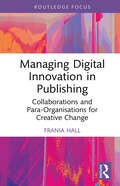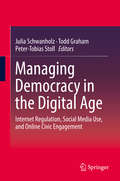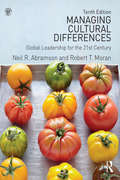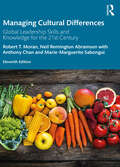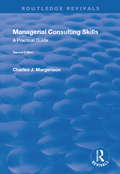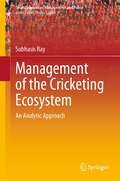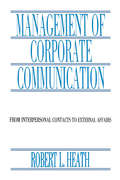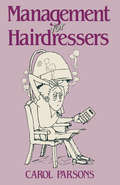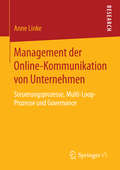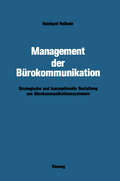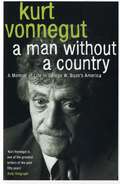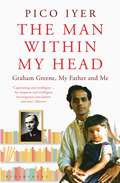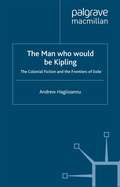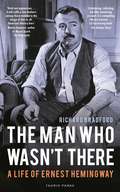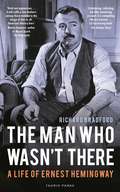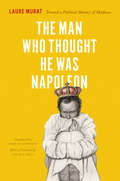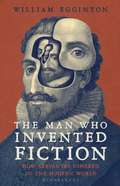- Table View
- List View
Managing Digital Innovation in Publishing: Collaborations and Para-Organisations for Creative Change
by Frania HallReflecting proactively on a growing industry 'dilemma', this book explores how publishing businesses can and do successfully experiment and innovate in digital publishing through collaboration.Many sectors of publishing are still structured around print production, with digital innovation in the consumer arena generally focused on different book formats, such e-books and audiobooks, rather than on brand-new types of products. Publishers need to innovate around different sorts of content and digital formats as consumers change their media habits. However, their pricing, business and risk models, and workflows are reflective of a legacy of print publishing; and as print commands so much revenue, publishers do not want to derail their main business as they experiment. Drawing on an analysis of collaboration and network theory and four in-depth qualitative case studies in different sectors, this research suggests that collaboration, particularly engaging with the wider creative sector, is key to the sustainable development of new types of products. It points to the characteristics of a successful digital collaboration and explains how to manage publishing innovation alongside the existing business, through para-organisations. Considering novel approaches to innovation, such as iterative software-style approaches and agile project management, as well as new business models, such as those employed in games development, the author shows how introducing new people – from software developers to competitors – can help instill a collaborative mindset within the organisation and facilitate constructive experimentation.Managing Digital Innovation in Publishing will be of interest to upper-level students and researchers of (digital) publishing and related creative industries.
Managing Democracy in the Digital Age: Internet Regulation, Social Media Use, and Online Civic Engagement
by Julia Schwanholz Todd Graham Peter-Tobias StollIn light of the increased utilization of information technologies, such as social media and the ‘Internet of Things,’ this book investigates how this digital transformation process creates new challenges and opportunities for political participation, political election campaigns and political regulation of the Internet. Within the context of Western democracies and China, the contributors analyze these challenges and opportunities from three perspectives: the regulatory state, the political use of social media, and through the lens of the public sphere. The first part of the book discusses key challenges for Internet regulation, such as data protection and censorship, while the second addresses the use of social media in political communication and political elections. In turn, the third and last part highlights various opportunities offered by digital media for online civic engagement and protest in the public sphere. Drawing on different academic fields, including political science, communication science, and journalism studies, the contributors raise a number of innovative research questions and provide fascinating theoretical and empirical insights into the topic of digital transformation.
Managing Cultural Differences: Global Leadership for the 21st Century
by Robert T. Moran Neil Remington AbramsonIn today’s global business environment, it is vital that individuals and organizations have sophisticated global leadership skills. Communication and understanding of different cultures is paramount to business success. This new edition of the bestselling textbook, Managing Cultural Differences, guides students and practitioners to an understanding of how to do business internationally, providing practical advice on how competitive advantage can be gained through effective cross-cultural management. Crises in the Middle East, the weakening of some emerging markets, and the value of diversity and inclusion are just a few examples of contemporary issues discussed in this text, which also introduces a completely new chapter on global business ethics. With a wealth of new examples, case studies, and online materials, this textbook is required course reading for undergraduates, postgraduates, and MBA students alike, as well as being a vital tool for anybody selling, purchasing, traveling, or working internationally.
Managing Cultural Differences: Global Leadership for the 21st Century (Managing Cultural Differences Ser.)
by Robert T. Moran Neil Remington AbramsonIn today’s global business environment, it is vital that individuals and organizations have sophisticated global leadership skills. Communication and understanding of different cultures is paramount to business success. This new edition of the bestselling textbook, Managing Cultural Differences, guides students and practitioners to an understanding of how to do business internationally, providing practical advice on how competitive advantage can be gained through effective cross-cultural management. Crises in the Middle East, the weakening of some emerging markets, and the value of diversity and inclusion are just a few examples of contemporary issues discussed in this text, which also introduces a completely new chapter on global business ethics. With a wealth of new examples, case studies, and online materials, this textbook is required course reading for undergraduates, postgraduates, and MBA students alike, as well as being a vital tool for anybody selling, purchasing, traveling, or working internationally.
Managing Cultural Differences: Global Leadership Skills and Knowledge for the 21st Century
by Robert T. Moran Neil Remington Abramson Anthony Chan Sabongui Marie-MargueriteIn today’s global business environment, it is vital that individuals and organizations have sophisticated global leadership skills. Communication and understanding of different cultures are paramount to business success. This new edition of the bestselling textbook Managing Cultural Differences guides students and practitioners to an understanding of how to do business internationally, providing practical advice on how competitive advantage can be gained through effective cross-cultural management. The digitization of the workplace, the integration of artificial intelligence into workplace cultures, cultural responses to crisis, and the value of diversity and inclusion are just a few examples of contemporary issues discussed in this text. This latest edition also begins with a completely new introductory chapter, which provides an overview and connects the themes between chapters for an integrated understanding of the topic. With a wealth of new examples, case studies, and online materials, this textbook is required course reading for undergraduates, postgraduates, and MBA students alike, as well as being a vital tool for anybody selling, purchasing, traveling, or working internationally.
Managing Cultural Differences: Global Leadership Skills and Knowledge for the 21st Century
by Robert T. Moran Neil Remington Abramson Anthony Chan Sabongui Marie-MargueriteIn today’s global business environment, it is vital that individuals and organizations have sophisticated global leadership skills. Communication and understanding of different cultures are paramount to business success. This new edition of the bestselling textbook Managing Cultural Differences guides students and practitioners to an understanding of how to do business internationally, providing practical advice on how competitive advantage can be gained through effective cross-cultural management. The digitization of the workplace, the integration of artificial intelligence into workplace cultures, cultural responses to crisis, and the value of diversity and inclusion are just a few examples of contemporary issues discussed in this text. This latest edition also begins with a completely new introductory chapter, which provides an overview and connects the themes between chapters for an integrated understanding of the topic. With a wealth of new examples, case studies, and online materials, this textbook is required course reading for undergraduates, postgraduates, and MBA students alike, as well as being a vital tool for anybody selling, purchasing, traveling, or working internationally.
Managerial Rhetoric and Arts Organizations
by L. ZanThe arts have faced big changes in recent years. This book explores the changes driven by the crisis of the welfare state and the privatization of public entities. It considers the tensions between managerial rhetoric and professional practices and questions the extension of managerial rhetoric for the very survival of arts organizations.
Managerial Consulting Skills: A Practical Guide (Routledge Revivals)
by Charles J. MargerisonThis title was first published in 2001. The advisory role in organizations is more important today than it has ever been. To perform effectively, managers and professionals need the skills of the consultant. This manual is designed to provide practical help for all advisers, whether working within or outside the organization. It covers every aspect of the process, from interpersonal skills to organizational context, from planning to follow-up. This second edition reflects developments which have taken place since the publication of the first edition and now includes ten chapters on the impact that action learning has on change processes and the way that the Web is likely to influence consulting. Each chapter concludes with guidelines summarizing the content, and questions designed to help the reader to apply the material to his or her own activities. Real-life cases from Dr Margerison's own experience are included, as well as examples drawn from the work of many well-known consultants.
Managerial Consulting Skills: A Practical Guide (Routledge Revivals)
by Charles J. MargerisonThis title was first published in 2001. The advisory role in organizations is more important today than it has ever been. To perform effectively, managers and professionals need the skills of the consultant. This manual is designed to provide practical help for all advisers, whether working within or outside the organization. It covers every aspect of the process, from interpersonal skills to organizational context, from planning to follow-up. This second edition reflects developments which have taken place since the publication of the first edition and now includes ten chapters on the impact that action learning has on change processes and the way that the Web is likely to influence consulting. Each chapter concludes with guidelines summarizing the content, and questions designed to help the reader to apply the material to his or her own activities. Real-life cases from Dr Margerison's own experience are included, as well as examples drawn from the work of many well-known consultants.
Management of the Cricketing Ecosystem: An Analytic Approach (Sports Economics, Management and Policy #20)
by Subhasis RayThis book is a culmination of sustained research work on the evaluation of cricket and its management to imbibe a balance between its various formats by using data and analytics. The book has identified three primary stakeholders—administrators, players and spectators—each having their own ambitions. In order for convergence of these ambitions, it has prescribed the networked governance in place of hierarchic governance for the International Cricket Council (ICC), the cricket’s apex body. This book aims at creating a balance between formats that each country should play. There is as much dearth of academic research on this topic, as there is abundance of individual viewpoints from professionals related to the game. Hence at the outset, the book has created a action points and has underlined the lack of convergence with present way of governance. This book has created a meta-metric framework for formative assessment of influence across cricket formats. In order to assess the influence of T20 on test matches and on India’s performance, a comparison between pre-IPL period (1998–2007) and post-IPL period (2008–2017) by using this framework has been done.
Management of Corporate Communication: From Interpersonal Contacts To External Affairs
by Robert L. HeathWhereas many organizational communication texts address internal communication processes, few consider the efforts that companies expend to communicate with external stakeholders. Likewise, many texts that concentrate on public relations or advertising consider external communication, but fail to give attention to internal communication. Combining both points of view, this text explains how an entire organization operates through enactments of personnel and external stakeholders. Central to this book is a concern for meaning and its influence on the performance of jobs in response to expectations of co-workers and external publics. The concept of narrative is used to explain how individual and organization performance is the expression of personae that are best when enacted jointly -- in varying degrees of coordination -- to satisfy mutual performance expectations. Narrative explains the power of organizational meaning, interpersonal contacts, group performance, stakeholder negotiation, and internal and external organizational zones of meaning -- assumptions that are shared by people who enact an organization through coordinated efforts.
Management of Corporate Communication: From Interpersonal Contacts To External Affairs (Routledge Communication Ser.)
by Robert L. HeathWhereas many organizational communication texts address internal communication processes, few consider the efforts that companies expend to communicate with external stakeholders. Likewise, many texts that concentrate on public relations or advertising consider external communication, but fail to give attention to internal communication. Combining both points of view, this text explains how an entire organization operates through enactments of personnel and external stakeholders. Central to this book is a concern for meaning and its influence on the performance of jobs in response to expectations of co-workers and external publics. The concept of narrative is used to explain how individual and organization performance is the expression of personae that are best when enacted jointly -- in varying degrees of coordination -- to satisfy mutual performance expectations. Narrative explains the power of organizational meaning, interpersonal contacts, group performance, stakeholder negotiation, and internal and external organizational zones of meaning -- assumptions that are shared by people who enact an organization through coordinated efforts.
Management der Online-Kommunikation von Unternehmen: Steuerungsprozesse, Multi-Loop-Prozesse und Governance
by Anne LinkeAnne Linke vergleicht kommunikationswissenschaftliche und betriebswirtschaftliche Konzepte des Kommunikationsmanagement-Prozesses in Unternehmen. Sie überträgt diese Erkenntnisse auf die Online-Kommunikation und erarbeitet daraus das „Multi-Loop-Modell“. Entsprechend Giddens` Strukturationstheorie und aufbauend auf der Governance-Forschung werden ferner dessen strukturelle Rahmenbedingungen betrachtet. Empirisch untersucht die Autorin fünf qualitative Fallbeispiele mittels Experteninterviews und Inhaltsanalysen. Anschließend wird der Status quo in Deutschland über eine quantitative Online-Befragung erhoben. Die Ergebnisse zeigen ein theoretisch fundiertes, systematisches Bild und fokussieren übergeordnete Veränderungen, Zusammenhänge sowie Unterschiede.
Management der Bürokommunikation: Strategische und konzeptionelle Gestaltung von Bürokommunikationssystemen
by Reinhard VoßbeinA Man Without a Country
by Kurt VonnegutA Man Without A Country is Kurt Vonnegut's hilariously funny and razor-sharp look at life, art, politics, himself and the condition of the soul of America today. Written over the last five years in the form of a loose memoir, with the examples of Mark Twain, Jesus Christ, Abraham Lincoln, and a saintly doctor named Ignaz Semmelweis powerfully in mind, A Man without a Country is an intimate and tender communication from one individual to his fellow humans - sometimes kidding, at other times despairing, always searching. It is illustrated throughout with Vonnegut's trademark artwork.
The Man Within My Head: Graham Greene, My Father and Me
by Pico IyerWe all carry other people inside our heads - actors, leaders, writers, people from history or fiction, met or unmet, who sometimes seem closer to us than people we know.In The Man Within My Head, Pico Iyer sets out to unravel the mysterious closeness he has always felt with the writer Graham Greene: he examines Greene's obsessions, his life on the road, his penchant for mystery. Iyer follows Greene's trail from his first novel, The Man Within, to such later classics as The Quiet American and begins to unpack all they have in common: a typical old-school education, a lifelong restlessness and refusal to make a home anywhere, a fascination with the complications of faith. The deeper Iyer plunges into their haunted kinship, however, the more he begins to wonder whether the man within his head is not Greene but his own father, or perhaps some more shadowy aspect of himself.Drawing upon experiences across the globe, from Cuba to Bhutan, and moving, as Greene would, from Sri Lanka at war to intimate moments of introspection; trying to make sense of his own past, commuting between the cloisters of a fifteenth-century boarding school and California in the 1960s, one of our most resourceful cultural explorers gives us his most personal and revelatory book yet, and one of the best new portraits of Greene himself.
The Man Who Would Be Kipling: The Colonial Fiction and the Frontiers of Exile
by A. HagiioannuThis study places Kipling's fiction in its original cultural, intellectual and historical contexts, exploring the impact of India, America, South Africa and Edwardian England on his imperialist narratives. Drawing on manuscripts, journalism and unpublished writings, Hagiioannu uncovers the historical significance and hidden meanings of a broad range of Kipling's stories, extending the discussion from the best-known works to a number of less familiar tales. Through a combination of close textual analysis and lively historical coverage, The Man Who Would Be Kipling suggests that Kipling's political ideas and narrative modes are more subtly connected with lived experience and issues of cultural environment than critics have formerly recognized.
The Man Who Wasn't There: A Life of Ernest Hemingway
by Richard BradfordErnest Hemingway was an involuntary chameleon, who would shift seamlessly from a self-cultivated image of hero, aesthetic radical, and existential non-conformist to a figure made up at various points of selfishness, hypocrisy, self-delusion, narcissism and arbitrary vindictiveness. Richard Bradford shows that Hemingway's work is by parts erratic and unique because it was tied into these unpredictable, bizarre features of his personality. Impressionism and subjectivity will always play some part in the creation of literary works but Hemingway was unique. He was a compulsive liar who eventually became unable to distinguish between the fantasies he spun for family and friends and the stories he told in his fiction.They are the writer's private signature, their authorial fingerprint. In this ground-breaking and intensely revealing biography, which includes a complete reassessment of Hemingway's oeuvre Hemingway's unfixed personality is shown to be the index to why and how he wrote as he did.
The Man Who Wasn't There: A Life of Ernest Hemingway
by Richard BradfordErnest Hemingway was an involuntary chameleon, who would shift seamlessly from a self-cultivated image of hero, aesthetic radical, and existential non-conformist to a figure made up at various points of selfishness, hypocrisy, self-delusion, narcissism and arbitrary vindictiveness. Richard Bradford shows that Hemingway's work is by parts erratic and unique because it was tied into these unpredictable, bizarre features of his personality. Impressionism and subjectivity will always play some part in the creation of literary works but Hemingway was unique. He was a compulsive liar who eventually became unable to distinguish between the fantasies he spun for family and friends and the stories he told in his fiction.They are the writer's private signature, their authorial fingerprint. In this ground-breaking and intensely revealing biography, which includes a complete reassessment of Hemingway's oeuvre Hemingway's unfixed personality is shown to be the index to why and how he wrote as he did.
The Man Who Thought He Was Napoleon: Toward a Political History of Madness
by Laure MuratThe Man Who Thought He Was Napoleon is built around a bizarre historical event and an off-hand challenge. The event? In December 1840, nearly twenty years after his death, the remains of Napoleon were returned to Paris for burial—and the next day, the director of a Paris hospital for the insane admitted fourteen men who claimed to be Napoleon. The challenge, meanwhile, is the claim by great French psychiatrist Jean-Étienne-Dominique Esquirol (1772–1840) that he could recount the history of France through asylum registries. From those two components, Laure Murat embarks on an exploration of the surprising relationship between history and madness. She uncovers countless stories of patients whose delusions seem to be rooted in the historical or political traumas of their time, like the watchmaker who believed he lived with a new head, his original having been removed at the guillotine. In the troubled wake of the Revolution, meanwhile, French physicians diagnosed a number of mental illnesses tied to current events, from “revolutionary neuroses” and “democratic disease” to the “ambitious monomania” of the Restoration. How, Murat asks, do history and psychiatry, the nation and the individual psyche, interface? A fascinating history of psychiatry—but of a wholly new sort—The Man Who Thought He Was Napoleon offers the first sustained analysis of the intertwined discourses of madness, psychiatry, history, and political theory.
The Man Who Thought He Was Napoleon: Toward a Political History of Madness
by Laure MuratThe Man Who Thought He Was Napoleon is built around a bizarre historical event and an off-hand challenge. The event? In December 1840, nearly twenty years after his death, the remains of Napoleon were returned to Paris for burial—and the next day, the director of a Paris hospital for the insane admitted fourteen men who claimed to be Napoleon. The challenge, meanwhile, is the claim by great French psychiatrist Jean-Étienne-Dominique Esquirol (1772–1840) that he could recount the history of France through asylum registries. From those two components, Laure Murat embarks on an exploration of the surprising relationship between history and madness. She uncovers countless stories of patients whose delusions seem to be rooted in the historical or political traumas of their time, like the watchmaker who believed he lived with a new head, his original having been removed at the guillotine. In the troubled wake of the Revolution, meanwhile, French physicians diagnosed a number of mental illnesses tied to current events, from “revolutionary neuroses” and “democratic disease” to the “ambitious monomania” of the Restoration. How, Murat asks, do history and psychiatry, the nation and the individual psyche, interface? A fascinating history of psychiatry—but of a wholly new sort—The Man Who Thought He Was Napoleon offers the first sustained analysis of the intertwined discourses of madness, psychiatry, history, and political theory.
The Man Who Thought He Was Napoleon: Toward a Political History of Madness
by Laure MuratThe Man Who Thought He Was Napoleon is built around a bizarre historical event and an off-hand challenge. The event? In December 1840, nearly twenty years after his death, the remains of Napoleon were returned to Paris for burial—and the next day, the director of a Paris hospital for the insane admitted fourteen men who claimed to be Napoleon. The challenge, meanwhile, is the claim by great French psychiatrist Jean-Étienne-Dominique Esquirol (1772–1840) that he could recount the history of France through asylum registries. From those two components, Laure Murat embarks on an exploration of the surprising relationship between history and madness. She uncovers countless stories of patients whose delusions seem to be rooted in the historical or political traumas of their time, like the watchmaker who believed he lived with a new head, his original having been removed at the guillotine. In the troubled wake of the Revolution, meanwhile, French physicians diagnosed a number of mental illnesses tied to current events, from “revolutionary neuroses” and “democratic disease” to the “ambitious monomania” of the Restoration. How, Murat asks, do history and psychiatry, the nation and the individual psyche, interface? A fascinating history of psychiatry—but of a wholly new sort—The Man Who Thought He Was Napoleon offers the first sustained analysis of the intertwined discourses of madness, psychiatry, history, and political theory.
The Man Who Thought He Was Napoleon: Toward a Political History of Madness
by Laure MuratThe Man Who Thought He Was Napoleon is built around a bizarre historical event and an off-hand challenge. The event? In December 1840, nearly twenty years after his death, the remains of Napoleon were returned to Paris for burial—and the next day, the director of a Paris hospital for the insane admitted fourteen men who claimed to be Napoleon. The challenge, meanwhile, is the claim by great French psychiatrist Jean-Étienne-Dominique Esquirol (1772–1840) that he could recount the history of France through asylum registries. From those two components, Laure Murat embarks on an exploration of the surprising relationship between history and madness. She uncovers countless stories of patients whose delusions seem to be rooted in the historical or political traumas of their time, like the watchmaker who believed he lived with a new head, his original having been removed at the guillotine. In the troubled wake of the Revolution, meanwhile, French physicians diagnosed a number of mental illnesses tied to current events, from “revolutionary neuroses” and “democratic disease” to the “ambitious monomania” of the Restoration. How, Murat asks, do history and psychiatry, the nation and the individual psyche, interface? A fascinating history of psychiatry—but of a wholly new sort—The Man Who Thought He Was Napoleon offers the first sustained analysis of the intertwined discourses of madness, psychiatry, history, and political theory.
The Man Who Invented Fiction: How Cervantes Ushered in the Modern World
by William Egginton'In 1605 a crippled, greying, almost toothless veteran of Spain's wars against the Ottoman Empire published a book. That book, Don Quixote, went on to sell more copies than any other book beside the Bible, making its author, Miguel de Cervantes, the most widely read author in human history. Cervantes did more than just publish a bestseller, though. He invented a way of writing.'In Cervantes' time, 'fiction' was synonymous with a lie. Books were either history, and true, or 'poetry' which might be invented, but had to conform to strict principles. Don Quixote tells the story of a poor nobleman, addled from reading too many books on chivalry, who deludes himself that he is a knight errant and sets off to put the world to rights. The book was hugely entertaining, broke the existing rules, devised a new set and, in the process, created a new, modern hybrid form we know today as the novel.The Man Who Invented Fiction explores Cervantes's life and the world he lived in, showing how his life and influences converged in his work, and how his work – especially Don Quixote – radically changed the nature of literature and created a new way of viewing the world. Finally, it explains how that worldview went on to infiltrate art, politics and science, and how the world today would be unthinkable without it.
